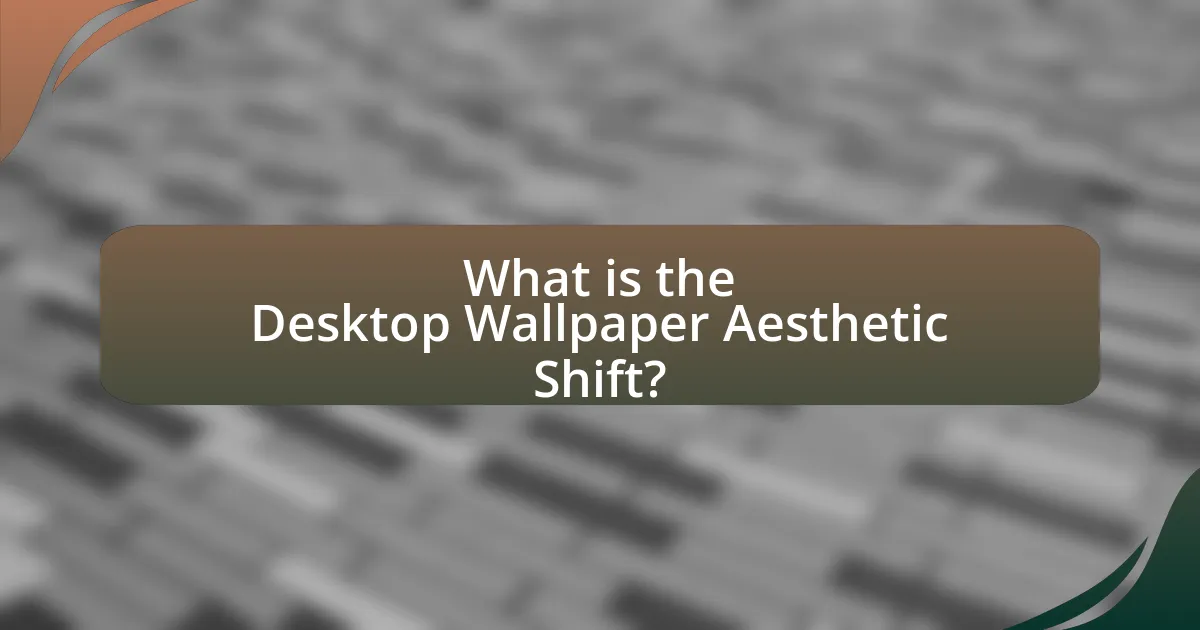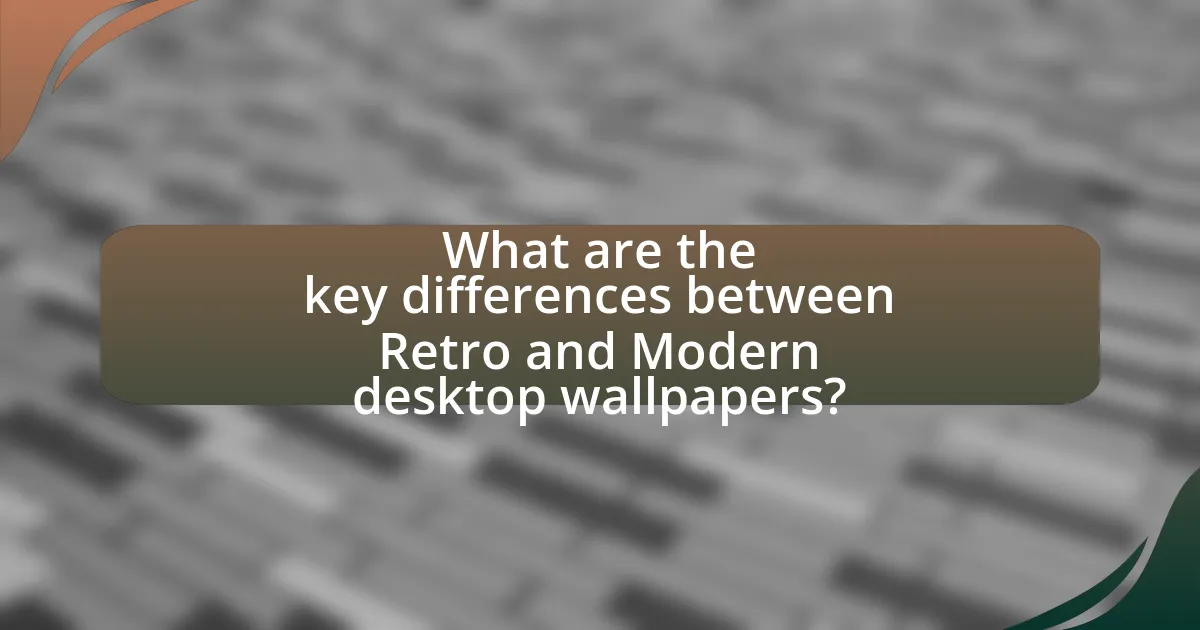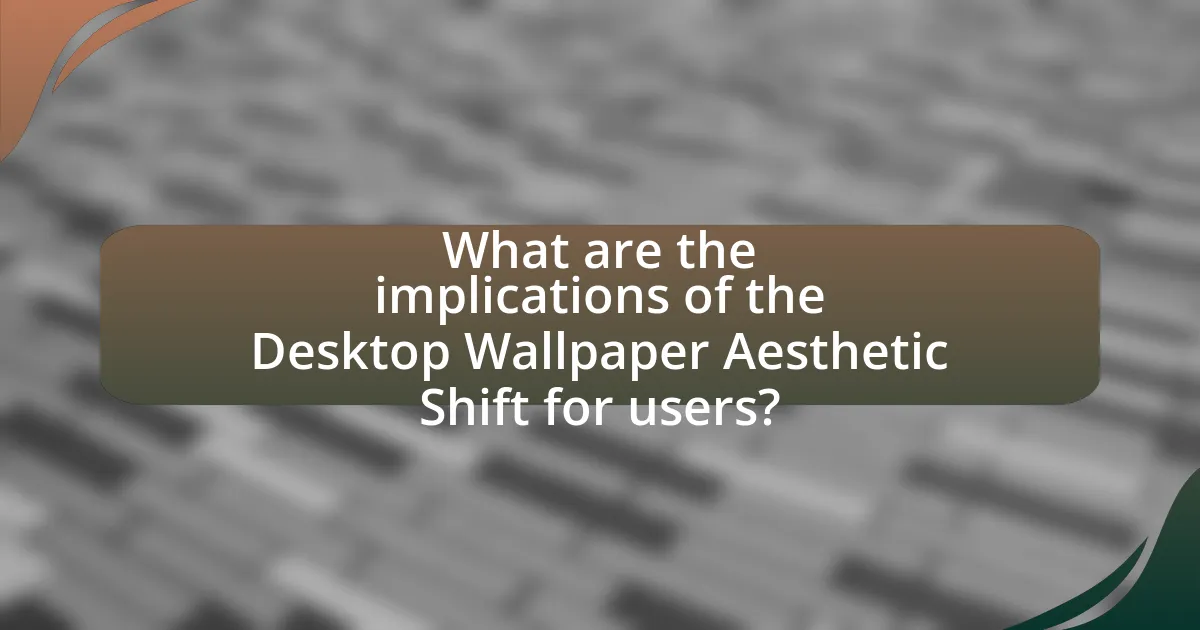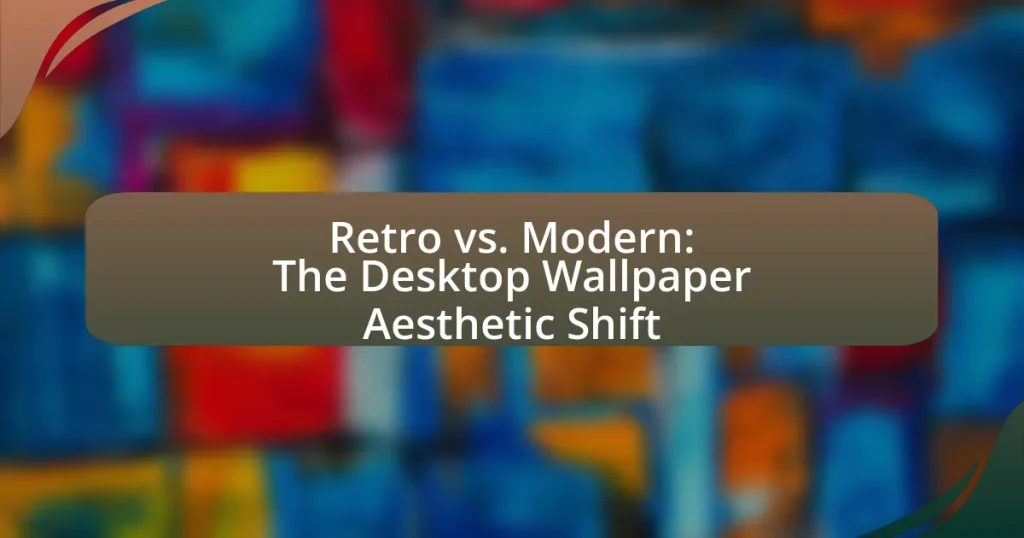The article examines the Desktop Wallpaper Aesthetic Shift, highlighting the transition from retro styles, characterized by vibrant colors and nostalgic themes, to modern aesthetics that prioritize minimalism and abstract designs. It details the evolution of desktop wallpaper aesthetics over time, defining the characteristics of both retro and modern designs, including their color palettes and typography. The significance of this shift is explored in relation to broader cultural and technological changes, emphasizing its impact on user experience, personalization, and productivity. Additionally, the article provides guidance on how users can choose between retro and modern wallpapers, blend elements from both styles, and optimize their desktop setups for enhanced visual appeal and functionality.

What is the Desktop Wallpaper Aesthetic Shift?
The Desktop Wallpaper Aesthetic Shift refers to the transition in design trends for desktop wallpapers from retro styles, characterized by vibrant colors and nostalgic themes, to modern aesthetics that emphasize minimalism, abstract designs, and muted color palettes. This shift reflects broader cultural changes in digital design preferences, where users increasingly favor clean, uncluttered visuals that enhance productivity and focus. The rise of flat design and the influence of mobile interfaces have further accelerated this trend, leading to a significant decline in the use of complex, illustrative wallpapers that were popular in earlier decades.
How has the aesthetic of desktop wallpapers evolved over time?
The aesthetic of desktop wallpapers has evolved significantly from simple, pixelated designs to complex, high-resolution images. In the early days of computing, wallpapers featured basic graphics and solid colors, often reflecting the limitations of technology. As display resolutions improved in the late 1990s and early 2000s, wallpapers transitioned to more intricate designs, including photographic images and digital art. The introduction of widescreen monitors further influenced this evolution, leading to wallpapers that embraced broader landscapes and more dynamic compositions. Today, modern desktop wallpapers often incorporate minimalistic designs, abstract art, and personalized themes, reflecting individual user preferences and the influence of social media platforms. This shift illustrates a broader trend in digital aesthetics, where user experience and personalization have become paramount.
What are the defining characteristics of retro desktop wallpapers?
Retro desktop wallpapers are characterized by vibrant colors, geometric patterns, and nostalgic imagery that evoke the aesthetics of past decades, particularly the 1980s and 1990s. These wallpapers often feature pixel art, abstract designs, and iconic pop culture references, reflecting the technological limitations and artistic styles of earlier computer graphics. The use of bold typography and a playful, whimsical approach further enhances their distinctive appeal, making them a popular choice for those seeking a sense of nostalgia in their digital environments.
What features distinguish modern desktop wallpapers?
Modern desktop wallpapers are distinguished by their high resolution, vibrant colors, and minimalist designs. High resolution, often exceeding 4K, allows for crisp and detailed images that enhance visual clarity on various screen sizes. Vibrant colors are utilized to create striking visuals that capture attention and evoke emotions, while minimalist designs focus on simplicity and functionality, reducing visual clutter. Additionally, modern wallpapers often incorporate dynamic elements, such as animated backgrounds or interactive features, which enhance user engagement. These characteristics reflect contemporary design trends that prioritize aesthetics and user experience in digital environments.
Why is the aesthetic shift in desktop wallpapers significant?
The aesthetic shift in desktop wallpapers is significant because it reflects broader cultural and technological changes in society. This shift from retro styles, characterized by vibrant colors and nostalgic themes, to modern designs that emphasize minimalism and functionality, indicates a transition in user preferences towards simplicity and efficiency. For instance, studies show that modern wallpaper designs often prioritize user experience by reducing visual clutter, which aligns with contemporary trends in digital interfaces and user-centered design principles. This evolution not only influences individual user choices but also impacts the overall design landscape in digital environments, making it a crucial aspect of understanding current aesthetic values.
How does the aesthetic shift reflect broader design trends?
The aesthetic shift from retro to modern in desktop wallpaper reflects broader design trends by emphasizing minimalism, functionality, and user experience. This transition aligns with the increasing preference for clean lines and simplicity in contemporary design, as seen in the rise of flat design and material design principles. For instance, the popularity of flat design, which gained traction with the introduction of Windows 8 and iOS 7, showcases a move away from ornate graphics towards more straightforward, user-friendly interfaces. This shift is further supported by research from the Nielsen Norman Group, which highlights that users favor designs that enhance usability and reduce cognitive load, reinforcing the trend towards modern aesthetics in digital environments.
What impact does the aesthetic shift have on user experience?
The aesthetic shift from retro to modern design significantly enhances user experience by improving visual appeal and usability. Modern aesthetics often prioritize minimalism, clarity, and functionality, which can lead to more intuitive navigation and reduced cognitive load for users. Research indicates that users are more likely to engage with interfaces that are visually pleasing and easy to understand, as demonstrated by studies showing that 94% of first impressions are design-related. This shift not only attracts users but also fosters a sense of trust and satisfaction, ultimately leading to increased user retention and interaction.

What are the key differences between Retro and Modern desktop wallpapers?
The key differences between Retro and Modern desktop wallpapers lie in their design elements, color palettes, and thematic content. Retro wallpapers often feature bold colors, geometric patterns, and nostalgic imagery that reflect styles from the 70s, 80s, and 90s, emphasizing a sense of nostalgia and vintage aesthetics. In contrast, Modern wallpapers tend to utilize minimalistic designs, softer color schemes, and abstract or nature-inspired themes, focusing on simplicity and functionality. This shift in design reflects broader trends in technology and user preferences, where modern aesthetics prioritize clean lines and usability over the ornate styles of the past.
What visual elements differentiate retro and modern styles?
Retro and modern styles are differentiated by their use of color palettes, typography, and design motifs. Retro styles often feature muted, pastel colors and bold, playful typography, reflecting design trends from the mid-20th century, such as the 1960s and 1970s. In contrast, modern styles typically utilize vibrant, saturated colors and minimalist typography, emphasizing clean lines and simplicity. Additionally, retro designs frequently incorporate nostalgic motifs like geometric patterns and vintage illustrations, while modern designs favor abstract shapes and digital aesthetics, aligning with contemporary design principles. This distinction is evident in the evolution of desktop wallpapers, where retro wallpapers evoke a sense of nostalgia, while modern wallpapers focus on sleek, functional aesthetics.
How do color palettes vary between retro and modern wallpapers?
Color palettes in retro wallpapers typically feature bold, vibrant hues and contrasting colors, while modern wallpapers often utilize softer, muted tones and monochromatic schemes. Retro designs, prevalent from the 1960s to the 1980s, emphasize bright colors like orange, teal, and yellow, reflecting the pop culture and design trends of that era. In contrast, modern wallpapers, influenced by minimalism and contemporary aesthetics, favor neutral colors such as grays, whites, and pastels, promoting a more subdued and sophisticated look. This shift in color palettes illustrates the evolution of design preferences, where retro styles celebrate exuberance and nostalgia, while modern styles prioritize simplicity and elegance.
What role does typography play in the aesthetic differences?
Typography significantly influences aesthetic differences by shaping visual perception and emotional response. In the context of retro versus modern desktop wallpapers, typography can evoke nostalgia or contemporary appeal, depending on the font style, size, and arrangement. For instance, retro designs often utilize serif fonts and playful lettering that reflect the design trends of past decades, creating a sense of familiarity and warmth. In contrast, modern aesthetics typically favor sans-serif fonts with clean lines and minimalistic layouts, which convey a sense of sophistication and clarity. Research indicates that typography affects user engagement and brand perception, with studies showing that 95% of first impressions are based on visual appearance, including typeface choice. Thus, typography serves as a critical element in distinguishing between retro and modern aesthetics in desktop wallpaper design.
How do cultural influences shape retro and modern wallpaper designs?
Cultural influences significantly shape retro and modern wallpaper designs by reflecting societal values, artistic movements, and technological advancements. For instance, retro wallpaper often incorporates patterns and colors that resonate with the aesthetics of specific historical periods, such as the bold geometric shapes of the 1960s or the floral motifs of the 1970s, which were influenced by the cultural revolutions and design philosophies of those times. In contrast, modern wallpaper designs frequently draw inspiration from contemporary art, minimalism, and global cultural exchanges, showcasing a blend of diverse styles and innovative materials. The rise of digital technology has also allowed for customizable designs that cater to individual tastes, further influenced by global trends and cultural narratives. This interplay between culture and design is evident in the way wallpaper evolves, adapting to the changing preferences and identities of society.
What historical events influenced retro wallpaper aesthetics?
The historical events that influenced retro wallpaper aesthetics include the post-World War II economic boom, the rise of the mid-century modern design movement, and the cultural shifts of the 1960s and 1970s. The post-war era saw increased consumerism and a demand for home decor that reflected optimism and innovation, leading to vibrant colors and bold patterns in wallpaper design. The mid-century modern movement, characterized by clean lines and organic forms, further shaped wallpaper aesthetics by promoting geometric patterns and abstract designs. Additionally, the counterculture movements of the 1960s and 1970s embraced psychedelic and eclectic styles, resulting in wallpapers that featured bright colors and whimsical motifs, reflecting the social changes and artistic experimentation of the time.
How do contemporary trends inform modern wallpaper designs?
Contemporary trends significantly inform modern wallpaper designs by emphasizing minimalism, sustainability, and digital integration. Designers are increasingly adopting minimalist aesthetics, characterized by clean lines and neutral color palettes, which reflect a broader cultural shift towards simplicity and functionality. Additionally, the growing demand for eco-friendly materials has led to the use of sustainable resources, such as recycled paper and non-toxic inks, aligning with global environmental concerns. Furthermore, the rise of digital technology has influenced wallpaper designs, allowing for customizable patterns and interactive elements that cater to individual preferences. This integration of contemporary trends ensures that modern wallpaper designs remain relevant and appealing in today’s market.

What are the implications of the Desktop Wallpaper Aesthetic Shift for users?
The implications of the Desktop Wallpaper Aesthetic Shift for users include changes in personalization, emotional engagement, and productivity. Users increasingly favor modern, minimalistic designs that enhance focus and reduce visual clutter, as evidenced by studies showing that clean aesthetics can improve cognitive performance. Additionally, the shift towards retro styles evokes nostalgia, which can enhance emotional well-being and user satisfaction. This duality in aesthetic preference reflects broader trends in digital culture, where users seek both functionality and emotional resonance in their digital environments.
How can users choose between retro and modern wallpapers?
Users can choose between retro and modern wallpapers by assessing their personal style preferences and the overall aesthetic they wish to create in their space. Retro wallpapers often feature bold patterns, vintage colors, and nostalgic themes that evoke a sense of history, while modern wallpapers typically emphasize minimalism, sleek designs, and contemporary color palettes. To make an informed choice, users should consider the mood they want to establish; for instance, retro styles can create a warm, inviting atmosphere, whereas modern designs may promote a clean, sophisticated look. Additionally, users can evaluate the compatibility of each wallpaper style with their existing decor, ensuring that the chosen wallpaper enhances the overall design rather than clashes with it.
What factors should users consider when selecting a wallpaper style?
Users should consider personal taste, room function, color scheme, and the overall aesthetic when selecting a wallpaper style. Personal taste influences the choice between retro and modern designs, while the function of the room—such as a calming bedroom versus a vibrant workspace—affects the style selection. The color scheme must complement existing decor to create a cohesive look. Additionally, the overall aesthetic, whether aiming for a nostalgic feel or a contemporary vibe, guides the decision-making process. These factors ensure that the chosen wallpaper enhances the space effectively.
How can users effectively blend retro and modern elements in their desktop setups?
Users can effectively blend retro and modern elements in their desktop setups by incorporating vintage-inspired accessories alongside contemporary technology. For example, using a retro-style keyboard or mouse can create a nostalgic feel while maintaining the functionality of modern devices. Additionally, selecting wallpapers that feature retro patterns or colors can harmonize with sleek, modern interfaces, creating a cohesive aesthetic. Research indicates that combining these styles can enhance user satisfaction and engagement, as it allows for personal expression while leveraging the efficiency of current technology.
What are some best practices for utilizing desktop wallpapers?
Best practices for utilizing desktop wallpapers include selecting high-resolution images to ensure clarity and visual appeal, organizing wallpapers into themed folders for easy access, and regularly updating wallpapers to maintain a fresh aesthetic. High-resolution images, typically 1920×1080 pixels or higher, prevent pixelation and enhance the overall desktop experience. Organizing wallpapers allows users to quickly switch between styles, catering to different moods or tasks. Regular updates can boost productivity and creativity by providing a stimulating visual environment, as studies suggest that changing visual stimuli can positively impact focus and motivation.
How can users optimize their desktop wallpaper for productivity?
Users can optimize their desktop wallpaper for productivity by selecting images that minimize distractions and enhance focus. Research indicates that wallpapers featuring simple designs or calming colors can reduce cognitive load, allowing users to concentrate better on tasks. For instance, a study published in the Journal of Environmental Psychology found that natural scenes, such as landscapes, can improve attention restoration and overall productivity. Additionally, using wallpapers that incorporate motivational quotes or reminders can serve as visual cues, reinforcing goals and enhancing motivation throughout the workday.
What tips can enhance the visual appeal of desktop wallpapers?
To enhance the visual appeal of desktop wallpapers, one effective tip is to choose high-resolution images that match the screen’s aspect ratio, ensuring clarity and detail. High-resolution images, typically 1920×1080 pixels or higher, prevent pixelation and maintain sharpness on modern displays. Additionally, selecting a color palette that complements the user’s overall desktop theme can create a cohesive look, as studies show that color harmony can significantly impact visual perception. Incorporating minimalistic designs or patterns can also enhance aesthetics by reducing clutter and focusing attention on essential elements. Lastly, using wallpapers that evoke personal interests or emotions can increase engagement and satisfaction, as psychological research indicates that personalized visuals can enhance user experience.
